2018 MITSUBISHI OUTLANDER III ESP
[x] Cancel search: ESPPage 161 of 441
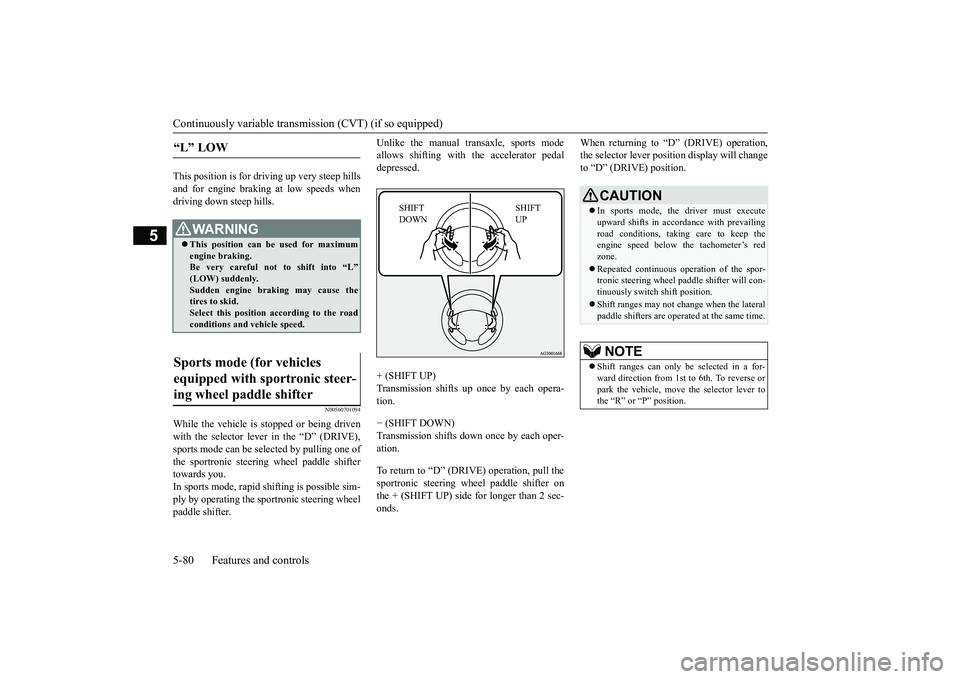
Continuously variable transmission (CVT) (if so equipped)5-80 Features and controls
5
This position is for driving up very steep hillsand for engine braking at low speeds whendriving down steep hills.
N00560701094
While the vehicle is stopped or being drivenwith the selector lever in the “D” (DRIVE),sports mode can be se
lected by pulling one of
the sportronic steering wheel paddle shiftertowards you.In sports mode, rapid
shifting is possible sim-
ply by operating the sportronic steering wheelpaddle shifter.
Unlike the manual transaxle, sports modeallows shifting with the accelerator pedaldepressed.+ (SHIFT UP)
up once by each opera-
tion.− (SHIFT DOWN)Transmission shifts down once by each oper-ation.To return to “D” (DRIVE) operation, pull thesportronic steering wheel paddle shifter onthe + (SHIFT UP) side for longer than 2 sec-onds.
When returning to “D” (DRIVE) operation,the selector lever posit
ion display will change
to “D” (DRIVE) position.
“L” LOW
WA R N I N GThis position can be used for maximumengine braking.Be very careful not to shift into “L”Sudden engine brak
ing may cause the
tires to skid.Select this position according to the roadconditions and vehicle speed.
Sports mode (for vehicles equipped with sportronic steer-ing wheel paddle shifter
SHIFT UP
SHIFT DOWN
CAUTIONIn sports mode, the driver must executeupward shifts in accordance with prevailingroad conditions, taking care to keep theengine speed below the tachometer’s redzone.Repeated continuous ope
ration of the spor-
tronic steering wheel pa
ddle shifter will con-
tinuously switch shift position.Shift ranges may not change when the lateralpaddle shifters are opera
ted at the same time.
NOTE
Shift ranges can only be
selected in a for-
ward direction from 1st to 6th. To reverse orpark the vehicle, move
the selector lever to
the “R” or “P” position.
BK0249100US.book 80 ページ 2017年5月10日 水曜日 午前8時49分
Page 166 of 441
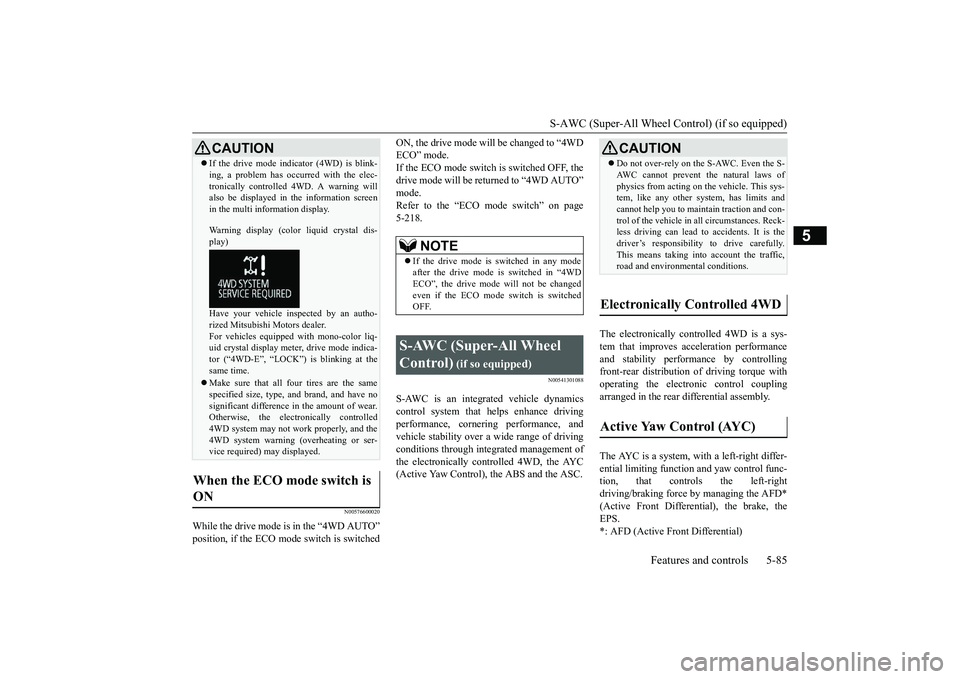
S-AWC (Super-All Wheel Co
ntrol) (if so equipped)
Features and controls 5-85
5
N00576600020
While the drive mode is in the “4WD AUTO”
ON, the drive mode will be changed to “4WDECO” mode.If the ECO mode switch is switched OFF, thedrive mode will be returned to “4WD AUTO”Refer to the “ECO mode switch” on page5-218.
N00541301088
S-AWC is an integr
ated vehicle dynamics
control system that helps enhance drivingperformance, cornering performance, andvehicle stability over a wide range of drivingconditions through integr
ated management of
the electronically cont
rolled 4WD, the AYC
(Active Yaw Control), the ABS and the ASC.
The electronically controlled 4WD is a sys-tem that improves acceleration performanceand stability performance by controllingfront-rear distribution of driving torque withoperating the electronic control couplingarranged in the rear differential assembly.The AYC is a system, with a left-right differ-ential limiting function
and yaw control func-
tion, that controls the left-rightdriving/braking force by managing the AFD*(Active Front Differential), the brake, theEPS.*: AFD (Active Front Differential)
If the drive mode indicator (4WD) is blink-ing, a problem has occurred with the elec-tronically controlled
4WD. A warning will
also be displayed in
the information screen
in the multi information display.Warning display (color
liquid crystal dis-
play)Have your vehicle in
spected by an autho-
rized Mitsubishi Motors dealer.For vehicles equipped with mono-color liq-uid crystal display mete
r, drive mode indica-
tor (“4WD-E”, “LOCK”)
is blinking at the
same time.Make sure that all four tires are the samespecified size, type, a
nd brand, and have no
significant difference
in the amount of wear.
Otherwise, the elec
tronically controlled
4WD system may not work properly, and the4WD system warning (overheating or ser-vice required) may displayed.
When the ECO mode switch is ON
CAUTION
NOTE
If the drive mode is switched in any modeafter the drive mode is switched in “4WDECO”, the drive mode
will not be changed
even if the ECO mode switch is switchedOFF.
S-AWC (Super-All Wheel Control)
(if so equipped)
Do not over-rely on the S-AWC. Even the S-AWC cannot prevent the natural laws ofphysics from acting on the vehicle. This sys-tem, like any other system, has limits andcannot help you to main
tain traction and con-
trol of the vehicle in
all circumstances. Reck-
less driving can lead to
accidents. It is the
driver’s responsibility to drive carefully.This means taking into account the traffic,road and environmental conditions.
Electronically Controlled 4WD
Active Yaw Control (AYC)
BK0249100US.book 85 ページ 2017年5月10日 水曜日 午前8時49分
Page 167 of 441
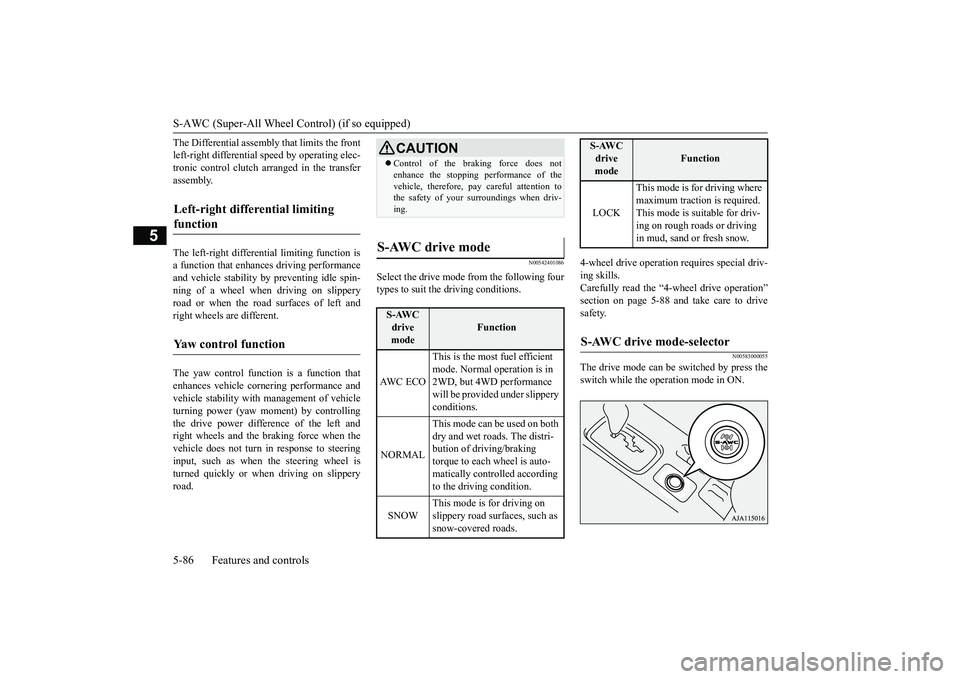
S-AWC (Super-All Wheel Control) (if so equipped)
5
The Differential assembly that limits the frontleft-right differential
speed by operating elec-
tronic control clutch arranged in the transferassembly.The left-right differen
tial limiting function is
a function that enhanc
es driving performance
and vehicle stability by preventing idle spin-ning of a wheel when driving on slipperyroad or when the road surfaces of left andright wheels are different.The yaw control function is a function thatenhances vehicle corn
ering performance and
vehicle stability with
management of vehicle
turning power (yaw moment) by controllingthe drive power difference of the left andright wheels and the braking force when thevehicle does not turn
in response to steering
input, such as when the steering wheel isturned quickly or when driving on slipperyroad.
N00542401086
Select the drive mode from the following fourtypes to suit the driving conditions.
4-wheel drive operation requires special driv-ing skills.Carefully read the “4-wheel drive operation”section on page 5-88 and take care to drivesafety.
N00583000055
The drive mode can be switched by press theswitch while the operation mode in ON.
Left-right differential limiting function
Yaw control function
CAUTIONControl of the braking force does notenhance the stopping performance of thevehicle, therefore, pa
y careful attention to
the safety of your surroundings when driv-ing.
S-AWC drive mode
S-AWC drive mode
Function
AW C E C O
This is the most fuel efficient mode. Normal operation is in 2WD, but 4WD performance will be provided under slippery conditions.
NORMAL
This mode can be used on both dry and wet roads. The distri-bution of driving/braking torque to each wheel is auto-matically controlled according to the driving condition.
SNOW
This mode is for driving on slippery road surfaces, such as snow-covered roads.
LOCK
This mode is for driving where maximum traction is required. This mode is suitable for driv-ing on rough roads or driving in mud, sand or fresh snow.
S-AWC drive mode-selector
S-AWC drive mode
Function
BK0249100US.book 86 ページ 2017年5月10日 水曜日 午前8時49分
Page 168 of 441

S-AWC (Super-All Wheel Co
ntrol) (if so equipped)
Features and controls 5-87
5
If you press the switch, you can change thedrive mode in the order of AWC ECO, NOR-MAL, SNOW, LOCK, AWC ECO.
N00583100030
The currently selected drive mode is dis-played on the multi-information display.In addition, when the drive mode is changed,the selected mode appears on the interruptdisplay screen of the information screen inthe multi-information display.The drive mode display
will appear on the
information screen for a few seconds, andthen the original screen will return.
N00542501074
The S-AWC operation stat
us can be displayed
on the information screen in the multi-infor-mation display.To display the status, press the multi-informa-tion meter switch to change the informationscreen.Refer to “Information screen (With the igni-tion switch or the operation mode in ON)” on
CAUTIONDo not operate the drive mode-selector withthe front wheels spinning on a snowy road orin similar conditions
. The vehicle could
lunge in an unexpe
cted direction.
Driving on dry, paved roads in “LOCK”
fuel consumption and
noise.NOTE
The drive mode can be switched while driv-ing or stopped.
S-AWC drive mode display
Example: “AWC ECO” mode is selected.
CAUTIONIf the selected drive
mode indicator begins
blinking, the drive m
ode will automatically
switch to protect the drive-system compo-nents. A warning will
also be displayed in
the information screen in the multi informa-tion display.Warning displayReduce speed and, if the indicator stopsblinking, you may resume normal driving.
If the drive mode indicator (4WD) is blink-ing, a problem has oc
curred with the S-
AWC. A warning will
also be displayed in
the information screen in the multi informa-tion display.Warning displayHave your vehicle insp
ected by an autho-
rized Mitsubishi Motors dealer.Make sure that all four tires are the samespecified size, type, a
nd brand, and have no
significant difference in the amount of wearfor all 4 wheels. Otherwise, the S-AWC sys-tem may not work properly, and a 4WD sys-tem warning (overheating or servicerequired) may
be displayed.
S-AWC operation display
CAUTION
BK0249100US.book 87 ページ 2017年5月10日 水曜日 午前8時49分
Page 170 of 441

4-wheel drive operation
Features and controls 5-89
5
When turning a sharp corner in “4WDLOCK” (Electronically
controlled 4WD) or
“LOCK” (S-AWC) position at low speed, a
slight difference in
steering may be experi-
enced similar to feeling as if the brakes wereapplied. This is called tight corner brakingand results from each of the four tires being ata different distance from the corner. The phe-nomenon is typical of 4-wheel drive vehicles.If this occurs, either straighten out the steer-ing wheel or change to another mode.Set the drive mode-selector to “4WDAUTO”, “4WD LOCK” (Electronically con-trolled 4WD) or “SNOW” (S-AWC) in accor-dance with the road conditions, and thengradually depress the ac
celerator pedal for a
smooth start.
WA R N I N GDo not over-rely on th
e 4-wheel drive vehi-
cles. Even 4-wheel drive vehicles have lim-its to the system and ability to maintaincontrol and traction.
Reckless driving may
lead to accidents. Always drive carefully,taking account of the road conditions.Improperly operating
this vehicle on or
off-pavement can cause an accident orrollover in which you
and your passengers
could be seriously
injured or killed.
• Follow all instructions and guidelines inthe owner’s manual.• Keep your speed low and do not drivefaster than conditions.NOTE
Driving on rough roads can be hard on avehicle. Before you le
ave the pavement, be
sure all scheduled ma
intenance and service
has been done, and that
you have inspected
your vehicle. Pay spec
ial attention to the
condition of the ti
res, and check the tire pres-
sures.Mitsubishi Motors is not responsible to theoperator for any damage or injury caused orliability incurred by improper and negligentoperation of a vehicl
e. All techniques of
vehicle operation depend on the skill andexperience of the opera
tor and other partici-
pating parties. Any de
viation from the rec-
ommended operating instru
ctions above is at
their own risk.
Note that the stopping distance required ofthe 4-wheel drive vehicl
e differs very little
from that of the front-wheel drive vehicle.When driving on a snow-covered road or aslippery, muddy surface,
make sure that you
keep a sufficient dist
ance between your vehi-
cle and the one ahead of you.The driving posture should be more upright;adjust the seat to a good position for easysteering and pedal operati
on. Be sure to wear
the seat belt.After driving on rough roads, check eachpart of the vehicle and wash it thoroughlywith water. Refer to the “Inspection andmaintenance following rough road opera-tion” section and “Vehic
le care and Mainte-
nance” sections.CAUTIONSetting the drive mode-selector to “4WDLOCK” (Electronically
controlled 4WD) or
“LOCK” (S-AWC) position to drive on drypaved road will increa
se fuel consumption,
with possible noise generation.
Turning sharp corners
NOTE
On snowy or icy roads
NOTE
The use of snow tires is recommended.Maintain a safe distan
ce between
vehicles,
avoid sudden braking, and use engine brak-ing (downshifting).CAUTIONAvoid sudden braking,
sudden acceleration
and sharp turning. Sk
idding occurs and con-
trol of the vehicle could be lost.
BK0249100US.book 89 ページ 2017年5月10日 水曜日 午前8時49分
Page 173 of 441
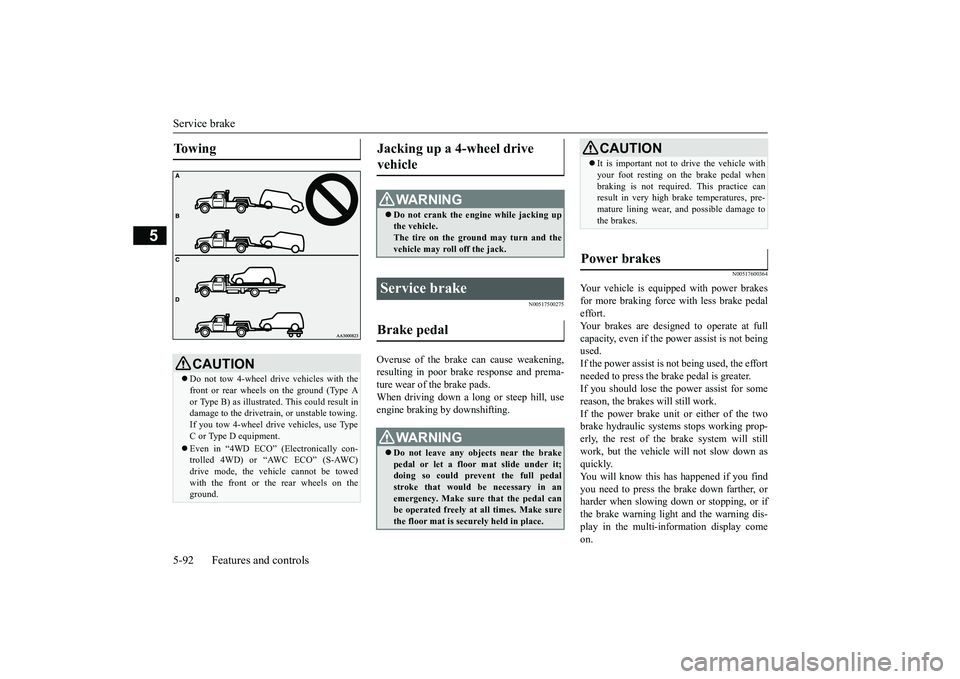
Service brake5-92 Features and controls
5
N00517500275
Overuse of the brake can cause weakening,resulting in poor brake response and prema-ture wear of the brake pads.When driving down a long or steep hill, useengine braking
by downshifting.
N00517600364
Your vehicle is equipped with power brakesfor more braking force with less brake pedaleffort.Your brakes are designed to operate at fullcapacity, even if the power assist is not beingused.If the power assist is not being used, the effortneeded to press the brake pedal is greater.If you should lose the power assist for somereason, the brakes will still work.If the power brake unit or either of the twobrake hydraulic systems stops working prop-erly, the rest of the brake system will stillwork, but the vehicle will not slow down asquickly.You will know this has happened if you findyou need to press the brake down farther, orharder when slowing down or stopping, or ifthe brake warning light and the warning dis-play in the multi-information display comeon.
To w i n g
CAUTIONDo not tow 4-wheel drive vehicles with thefront or rear wheels on the ground (Type Aor Type B) as illustrate
d. This could result in
damage to the drivetrain, or unstable towing.If you tow 4-wheel drive vehicles, use TypeC or Type D equipment.Even in “4WD ECO” (Electronically con-trolled 4WD) or “AWC ECO” (S-AWC)drive mode, the vehicle cannot be towedwith the front or the rear wheels on theground.
Jacking up a 4-wheel drive vehicle
WA R N I N GDo not crank the engine while jacking upthe vehicle.The tire on the ground may turn and thevehicle may roll off the jack.
Service brake Brake pedal
WA R N I N GDo not leave any objects near the brakepedal or let a floor mat slide under it;doing so could prevent the full pedalstroke that would be necessary in anemergency. Make sure that the pedal canbe operated freely at all times. Make surethe floor mat is securely held in place.
CAUTIONIt is important not to drive the vehicle withyour foot resting on the brake pedal whenbraking is not required.
This practice can
result in very high brake temperatures, pre-mature lining wear, a
nd possible damage to
the brakes.
Power brakes
BK0249100US.book 92 ページ 2017年5月10日 水曜日 午前8時49分
Page 178 of 441
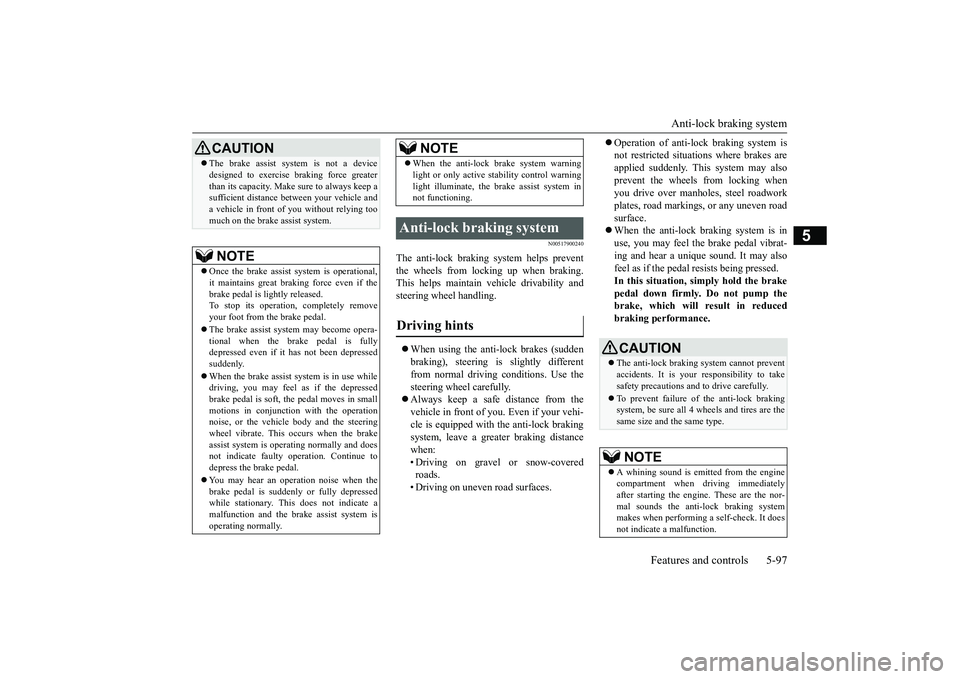
Anti-lock braking system
Features and controls 5-97
5
N00517900240
The anti-lock braking system helps preventthe wheels from locking up when braking.This helps maintain vehicle drivability andsteering wheel handling.When using the anti-lock brakes (suddenbraking), steering is slightly differentfrom normal driving conditions. Use thesteering wheel carefully.Always keep a safe distance from thevehicle in front of you. Even if your vehi-cle is equipped with
the anti-lock braking
system, leave a greater braking distancewhen:• Driving on gravel or snow-coveredroads.• Driving on uneven road surfaces.
Operation of anti-lock braking system isnot restricted situations where brakes areapplied suddenly. This system may alsoprevent the wheels from locking whenyou drive over manholes, steel roadworkplates, road markings
, or any uneven road
surface.When the anti-lock braking system is inuse, you may feel the brake pedal vibrat-ing and hear a unique sound. It may alsofeel as if the pedal
resists being pressed.
In this situation, si
mply hold the brake
pedal down firmly. Do not pump thebrake, which will result in reducedbraking performance.
CAUTIONThe brake assist system is not a devicedesigned to exercise
braking force greater
than its capacity. Make sure to always keep asufficient distance be
tween your vehicle and
a vehicle in front of
you without relying too
much on the brake assist system.NOTE
Once the brake assist system is operational,it maintains great braking force even if thebrake pedal is lightly released.To stop its operation, completely removeyour foot from the brake pedal.The brake assist system may become opera-tional when the brake pedal is fullydepressed even if it
has not been depressed
suddenly.When the brake assist system is in use whiledriving, you may feel as if the depressedbrake pedal is soft, the pedal moves in smallmotions in conjunction with the operationnoise, or the vehicle body and the steeringwheel vibrate. This occurs when the brakeassist system is ope
rating normally and does
not indicate faulty
operation. Continue to
depress the brake pedal.You may hear an operation noise when thebrake pedal is suddenl
y or fully depressed
while stationary. This does not indicate amalfunction and the brake assist system isoperating normally.
When the anti-lock brake system warninglight or only active st
ability control warning
light illuminate, the brake assist system innot functioning.
Anti-lock braking system Driving hints
NOTE
CAUTIONThe anti-lock braking system cannot preventaccidents. It is your
responsibility to take
safety precautions a
nd to drive carefully.
To prevent failure of the anti-lock brakingsystem, be sure all 4 wheels and tires are thesame size and the same type.NOTE
A whining sound is emitted from the enginecompartment when driving immediatelyafter starting the engine. These are the nor-mal sounds the anti-lock braking systemmakes when performing a self-check. It doesnot indicate
a malfunction.
BK0249100US.book 97 ページ 2017年5月10日 水曜日 午前8時49分
Page 181 of 441
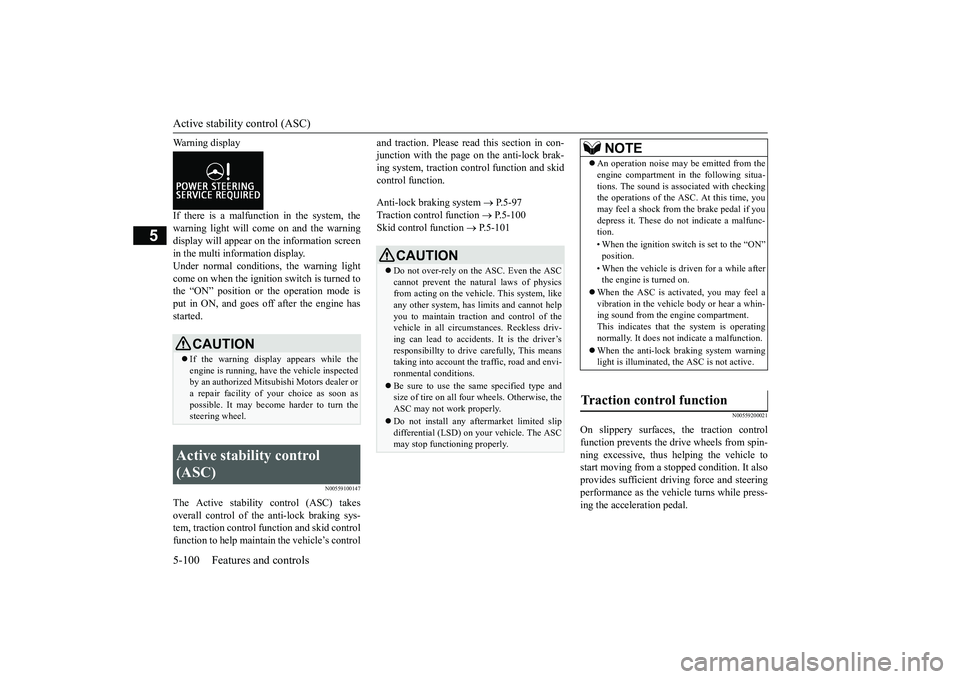
Active stability control (ASC)
5
Warning displayIf there is a malfunction in the system, thewarning light will come on and the warningdisplay will appear on the information screenin the multi information display.Under normal conditions, the warning lightcome on when the ignition switch is turned tothe “ON” position or the operation mode isput in ON, and goes off after the engine hasstarted.
N00559100147
The Active stability
control (ASC) takes
overall control of the
anti-lock braking sys-
tem, traction control function and skid controlfunction to help maintain the vehicle’s control
and traction. Please read
this section in con-
junction with the page on the anti-lock brak-ing system, traction c
ontrol function and skid
control function.Anti-lock braking system
P.5-97
Traction control function
P.5-100
Skid control function
P.5-101
N00559200021
On slippery surfaces, the traction controlfunction prevents the drive wheels from spin-ning excessive, thus helping the vehicle tostart moving from a stopp
ed condition.
It also
provides sufficient driv
ing force and steering
performance as the vehicle turns while press-ing the acceleration pedal.
CAUTIONIf the warning display appears while theengine is running, have
the vehicle inspected
by an authorized Mitsubishi Motors dealer ora repair facility of
your choice as soon as
possible. It may become harder to turn thesteering wheel.
Active stability control (ASC)
CAUTIONDo not over-rely on the ASC. Even the ASCcannot prevent the natural laws of physicsfrom acting on the vehicle. This system, likeany other system, has
limits and cannot help
you to maintain traction and control of thevehicle in all circumstances. Reckless driv-ing can lead to accident
s. It is the driver’s
responsibillty to drive carefully, This meanstaking into account the traffic, road and envi-ronmental conditions.Be sure to use the same specified type andsize of tire on all four
wheels. Otherwise, the
ASC may not work properly.Do not install any aftermarket limited slipdifferential (LSD) on your vehicle. The ASCmay stop functioning properly.
NOTE
An operation noise may be emitted from theengine compartment in the following situa-tions. The sound is associated with checkingthe operations of the ASC. At this time, youmay feel a shock from the brake pedal if youdepress it. These do not indicate a malfunc-tion.• When the ignition switc
h is set to the “ON”
• When the vehicle is driven for a while afterthe engine is turned on.
When the ASC is acti
vated, you may feel a
vibration in the vehicl
e body or hear a whin-
ing sound from the engine compartment.This indicates that th
e system is operating
normally. It does not i
ndicate a malfunction.
When the anti-lock braking system warninglight is illuminated, the ASC is not active.
Traction control function
BK0249100US.book 100 ページ 2017年5月10日 水曜日 午前8時49分